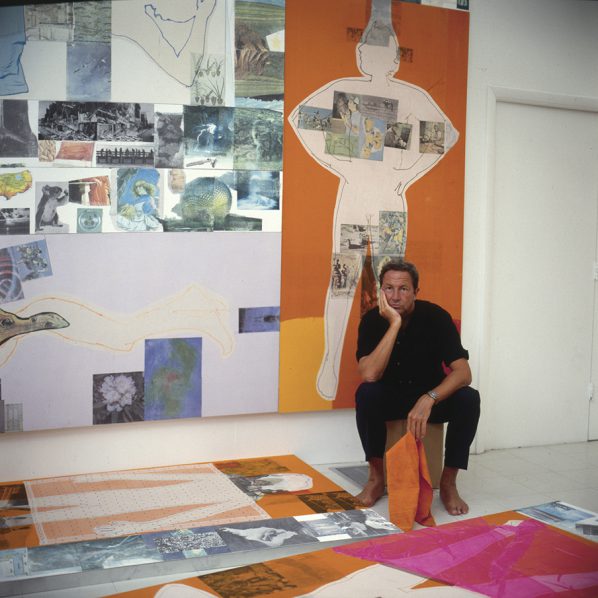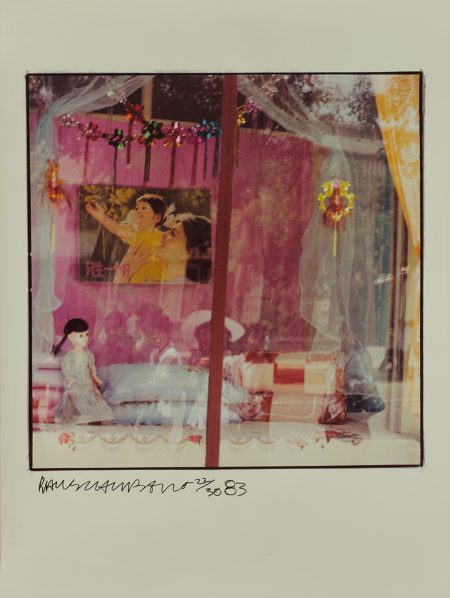
Robert Rauschenberg (1925–2008), The 14 Mile or 2 Furlong Piece (detail), 1981-98; © 2016 Robert Rauschenberg Foundation
The Ullens Center for Contemporary Art (UCCA) is proud to present “Rauschenberg in China.” On view in UCCA’s Great Hall from 12 June to 21 August 2016, the exhibition centers on Robert Rauschenberg’s (1925-2008) magnum opus The 1/4 Mile or 2 Furlong Piece (1981–98), its 190 parts stretching approximately 305 meters and exhibited for the first time since 2000. Also included in the exhibition is a selection of Rauschenberg’s color photographs titled Studies for Chinese Summerhall (1983), taken during the artist’s travels in China in 1982. Accompanying these works is a collection of documentation and ephemera related to Rauschenberg’s transformational 1985 exhibition “ROCI CHINA” at the institution now known as the National Art Museum of China. These archival materials offer a rare glimpse into the historical moment when the artist’s global quest for inspiration and cultural exchange through art put him in front of an emerging generation of Chinese artists, during a period that would later come to be known as the “’85 New Wave.” Organized in collaboration with the Robert Rauschenberg Foundation and curated by Susan Davidson and David White, “Rauschenberg in China” is the first major exhibition in over three decades to showcase the artist’s work to Chinese audiences.

Rauschenberg working on The 14 Mile or 2 Furlong Piece (1981–98) in his studio, Captiva, Florida, ca. 1983 Photograph Collection. Robert Rauschenberg Foundation Archives, New York. Photo: Attributed to Terry Van Brunt
A masterwork often read as a self-contained retrospective, The 1/4 Mile was completed over a seventeen year period from 1981 to 1998 and reflects major themes from throughout Rauschenberg’s oeuvre, ranging from his White Paintings, Combines, Cardboards, and Gluts to collages composed with either found images or the artist’s own photographs. The earliest inspiration for the piece may have come from collectors Robert and Jane Meyerhoff, whose colt, which they had named Rauschenberg, won the Maryland Day purse in 1981. The furlong is a unit of measurement used in horse racing, and two furlongs the distance between Rauschenberg’s home and studio on Captiva Island, Florida, reiterating the artist’s constant theme of the connection between art and life. In quintessentially Rauschenbergian fashion, the components that make up The 1/4 Mile disregard traditional limitations of painting and sculpture. Patterned shirts, constructions made from found objects salvaged from junkyards, and silkscreened images on Lexan panels move across walls and into the exhibition space as a single work. This expansive artwork also incorporates an audio component comprising a cacophony of street sounds collected from the artist’s travels. The first half of The 1/4 Mile inaugurated the Lila Acheson Wallace Wing of New York’s Metropolitan Museum of Art in 1987, remaining on view for eleven months. The piece was later shown in its near-entirety as part of the artist’s 1997 retrospective at the Solomon R. Guggenheim Museum, New York, subsequently traveling to the Museum of Fine Arts Houston and Guggenheim Bilbao in 1998. Its most recent public showing prior to this exhibition inaugurated Mass MoCA, North Adams, Massachusetts, in 1999. Rauschenberg continuously added and revised The 1/4 Mile during its extended period of creation, and each presentation has responded to the architectural configurations of its venue.

Robert Rauschenberg (1925–2008) The 1/4 Mile or 2 Furlong Piece1981–98Panels 116 to 120 116: Silkscreened ink and acrylic on anodized mirrored aluminum 117 to 120: Silkscreened ink and acrylic on enameled aluminum 304.8 x 121.9 cm each Robert Rauschenberg Foundation© 2016 Robert Rauschenberg Foundation
Alongside The 1/4 Mile, “Rauschenberg in China” also features Studies for Chinese Summerhall, two portfolios of images taken during Rauschenberg’s first trip to China in the early summer of 1982, the only body of color photography the artist designated as art. Outfitted with a Hasselblad camera, Rauschenberg recorded scenes of daily life in early Reform-era China, captured through his sharp eye for composition and unique sensitivity toward beauty in the mundane, and relating to elements of urban environments and landscapes that had frequently appeared in photographs made throughout his career. These rarely seen images were made as studies for the monumental thirty-meter scroll-like photograph, Chinese Summerhall (1982), one of the centerpieces of his 1985 “ROCI CHINA” exhibition in Beijing.

Robert Rauschenberg (1925–2008) Study for Chinese Summerhall1983 Chromogenic print 66 x 66 cm image; 101.6 x 76.2 cm sheet Robert Rauschenberg Foundation© Robert Rauschenberg Foundation 2016
Commemorating Rauschenberg’s interactions in China in the 1980s, is a selection of ephemera and archival materials documenting his initial trip to one of the world’s oldest paper mills in Jingxian, Anhui province, as well as his 1985 exhibitions in Beijing and Lhasa. Presentations in both cities were part of ROCI—the Rauschenberg Overseas Culture Interchange—a serial project of international exhibitions held between 1985 and 1991 in Chile, Cuba, Germany, Japan, Malaysia, Mexico, the Soviet Union, and Venezuela, culminating at the National Gallery in Washington, D.C. in 1991. The selection on view here includes hand-written statements, official documents, and brochures on the exhibition as well as a video Travelogue documenting Rauschenberg’s 1982 trip. “ROCI CHINA” confounded and inspired viewers, whose exposure to Western art had been limited to reproductions within catalogues, and whose understanding of art had largely been confined to academic painting, sculpture, and printmaking. During its three-week run (15 November – 5 December 1985), the exhibition attracted more than 300,000 visitors. The idea for ROCI actually grew out of Rauschenberg’s 1982 China trip. “The interaction that occurred in Jingxian, between old and new, East and West, parochial and international, gave to the ROCI project the impetus and energy, both artistic and practical, that would fuel it on a global scale. ROCI became, consequently, a mode of communication and a bridge between disparate cultures,” wrote ROCI artistic director Donald Saff.
“We are thrilled to revisit Rauschenberg’s unique position in China’s contemporary art history through a substantive presentation of a major work which was created at exactly the moment of this encounter,” notes UCCA Director Philip Tinari. “It is particularly exciting to be opening our exhibition in the same year as the Tate and MoMA retrospective, and thus to be participating in a worldwide reassessment of Rauschenberg’s multifaceted, global legacy. We hope that this exhibition will illustrate not only how Rauschenberg inspired China, but how China inspired him.”
About the exhibition
Date: 2016.06.12 – 2016.08.21
Venue: Great Wall, UCCA
Courtesy of the Robert Rauschenberg Foundation and UCCA, for further information please visit http://ucca.org.cn.




























